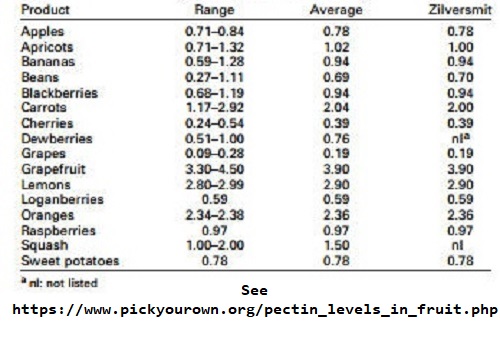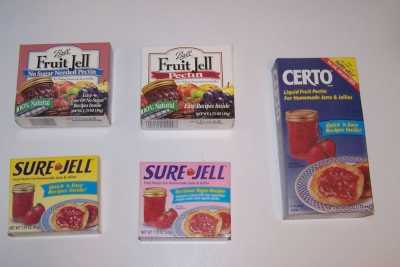
Pectin Levels in Fruit and Vegetables
Pectin is commonly used as a dietary supplement and in cooking, principally as a thickener for jams and jellies. It has become one of the new superfoods or super-supplements. Whether the claims for the benefits of pectin in diet are realistic is a subject for another debate; of current interest here is the pectin levels of various fruits and vegetables. That is also subject to debate, as there are factors that affect the values measure, such as:
- Are only edible portions sampled and measured?
- Test methods used
- Which form is measured, soluble pectin citrate or pectin acid
Background
Pectin is a naturally occurring substance (a polysaccharide) found in berries, apples and other fruit. When heated together with sugar, it causes a thickening that is characteristic of jams and jellies.
You can also make your own pectin. Just see this page for directions. And if you are just looking ffor the best prices and all the options for pectin, click here!
Most pectin you buy at the supermarket is produced in Europe and imported to the U.S.. It has a limited shelf life; usually you don't want to keep it from year to year, as it's ability to gel will decrease.
Pectin concentrations in fruit and vegetables.
As applicable to making Jams and Jellies
| Group I: | If not overripe, it usually has enough natural pectin and acid for gel formation with only added sugar. | |
| Group II: | Low in natural acid or pectin, and may need addition of either acid or pectin. | |
| Group III: | Always needs added acid, pectin or both. |
|
Group I If not overripe, has enough natural pectin and acid for gel formation with added sugar only. |
Group II Low in natural acid or pectin; might need addition of either acid or pectin. |
Group III Always needs added acid, pectin or both. |
| Apples, sour | Apples, ripe | Apricots |
| Blackberries, sour | Blackberries, ripe | Blueberries |
| Citrus skins (oranges, tangerines, grapefruit, lemons, limes, etc. - the pectin is high in the skin but low in the fruit) | Cherries, sour | Cherries, sweet |
| Crabapples | Chokecherries | Figs |
| Cranberries | Elderberries | Grapefruit |
| Currants | Grape Juice, bottled (Eastern Concord) | Grapes (Western Concord) |
| Gooseberries | Grapes (California, and all other than Concord) | Guavas |
| Grapes (Eastern Concord) | Loquats | Nectarines |
| Lemons | Oranges | Peaches |
| Loganberries | Pears | |
| Plums (not Italian) | Plums (Italian) | |
| Quinces | Pomegranates | |
| Raspberries * see note below | ||
| Strawberries |
* Raspberries are always identified by researchers as low in pectin. But many home jam-makers have found they often behave as though they have high pectin levels. I usually add a small amount of pectin to raspberries, and get a firm set.
Commercial pectins are made from apples or citrus fruit and are available in both powdered and liquid forms. Be sure to follow the manufacturer's directions when using commercial pectin. The powdered and liquid forms are not interchangeable in recipes.

The table at above shows a lab-tested comparison of fresh weight pectin content values from Campbell and Palmer (1978) (expressed by the authors as calcium pectate) with values from Zilversmit (1979) Product Campbell and Palmer Range Average Zilversmit.
The table below takes the data from table one with and compares it the study's review of published values (the reference column)

The pectin content in all fruit is also generally higher when fruit is just barely ripe and diminishes as it matures from fully ripe to overripe. The process of ripening involves the breakdown of pectins, which softens the fruit as it ripens. Apples and crabapples (especially unripe ones) are good sources of pectin and are often used in making commercial pectin. Some commercial pectin is made from citrus peels.
Testing for Pectin
There is a test that uses rubbing alcohol to provide a rough indication of the amount of pectin in the fruit. Mix 1 teaspoon of cooked, cooled crushed fruit with 1 tablespoon of rubbing alcohol. Use a closed container and shake gently. Juices from fruit that is high in pectin will form a solid gelatinous lump. If the fruit is low in pectin, it will form only small rubbery particles. Those with an average pectin content will form a few pieces of the jelly-like substance.
It ought to be needless to say, that just as you should never put a cup of very hot coffee in your lap while driving a car, you should not eat the test mixture (that with the rubbing alcohol in it) as rubbing alcohol is a poison.
ess than 1/2 cup in volume. So, a little less than 1/2 cup of dry pectin equals 1 pouch of liquid pectin.
Note: ClearJel is a starch that is used in making pie fillings. It is not a pectin, but a unique starch that is safer to use in making pie fillings, like home canning apple pie filling or blueberry pie filling. as it is more uniform for heat distribution.
Samples of Commercial PectinTop left: no-sugar Ball dry pectin Top right: regular Ball dry pectin Bottom left: regular SureJell dry pectin Bottom right: lower sugar SureJell dry pectin Far right: Certo liquid regular pectin |
|
Where to get pectin
Pectin is commonly sold in large grocery stores, like Publix and Kroger, housewares sections of stores like local "big box" stores, and online. We have affiliate programs with two suppliers:
| Brick and Mortar Stores | No-sugar pectin (This is my top choice, since you can use no sugar, sugar, honey and/or Stevia (in a prepared form like Truvia, it measures same as sugar; if you use another form, you will need do your own conversion) - or Splenda, if you prefer, and it will set!) |
Regular pectin I still think you should use the no-sugar version (at left), even if you want to add sugar!). Most grocery stores carry it. |
Low sugar methoxyl pectin (Pomona) Best for tough sets, like pepper jellies. You can find this usually at Wal-Mart. |
MCP - Modified Citrus Pectin Made with fruit pectin and citric acid. Mostly sold online. |
Freezer jam pectin Some grocery stores carry it. |
Liquid pectin I have seen it in a few rocery stores. |
low sugar pectin It hardly ever sold now. |
| Online stores | FitLane low sugar pectin in a bulk packet (in 1 lb / 16 ox bag) - This is by far, the best price for bulk low/ sugar pectin).. | Bulk Anthony's Premium Fruit Regular Pectin, 1.5 lb, Gluten Free, Non GMO, Vegan Great prices for bulk regular pectin that is also vegan, non-gmo (all pectin is gluten free) | Pomona Low sugar methoxyl pectin, a.k.a, Pomona's Universal Pectin in 1 lb bulk package. A bit better price than in packets. | MCP pectin | See here for related tools, equipment, supplies on Amazon | It is hard to find - but the no-sugar pectin works well with sugar, too |
Bulk pectin for canning multiple batches of jam and jelly at lower cost:
No-sugar needed bulk pectin:See here for related tools, equipment, supplies on Amazon
Regular (sugar needed) bulk pectin:
See here for related tools, equipment, supplies on Amazon
Can't find the Pectin? Our affiliate suppliers ship to all 50 states!
References:
-
Reassessment of Some Fruit and Vegetable Pectin Levels
USDA, ROBERT A. BAKER, Volume 62, No. 2, 1997; JOURNAL OF FOOD SCIENCE; 229 - National Center for Home Food Preservation (at UGA).
- Ohio State University Extension
Illustrated Canning, Freezing, Jam Instructions and Recipes
[ Easy Home Canning Directions] [FAQs - Answers to common questions and problems] [Recommended books about home canning, jam making, drying and preserving!] [Free canning publications to download and print]
Looking for canning equipment and supplies?
Water bath canner with a jar rack
Pressure canners for gas, electric and induction stoves: Presto 23Qt or T-fal 22Qt
Canning scoop (this one is PERFECT)
Ball Blue book (most recent version)
Jars: 8oz canning jars for jams
Find Other types of farms:
Farm markets and roadside stands
Road trips and camping resources
Local Honey, apiaries, beekeepers
Consumer fraud and scams information
Home canning supplies at the best prices on the internet!
Maple Syrup Farms, sugarworks, maple syrup festivals
Environmental information and resources
Farms For Your Event for birthday parties, weddings, receptions, business meetings, retreats, etc.
Festivals - local fruit and vegetable festivals
Get the
most recent version of
the Ball Blue Book
With this Presto 23 quart pressure canner and pressure cooker, you can "can" everything, fruits, vegetables, jams, jellies, salsa, applesauce, pickles, even meats, soups, stews. Model 01781

You can make jams, jellies, can fruit, applesauce, salsa and pickles with water bath canners, like this Granite Ware 12-Piece Canner Kit, Jar Rack, Blancher, Colander and 5 piece Canning Tool Set


